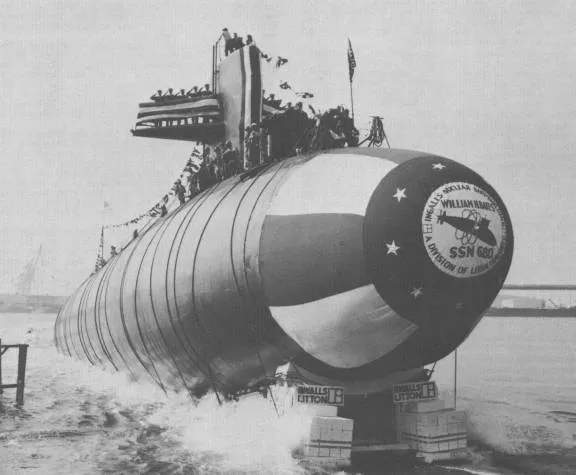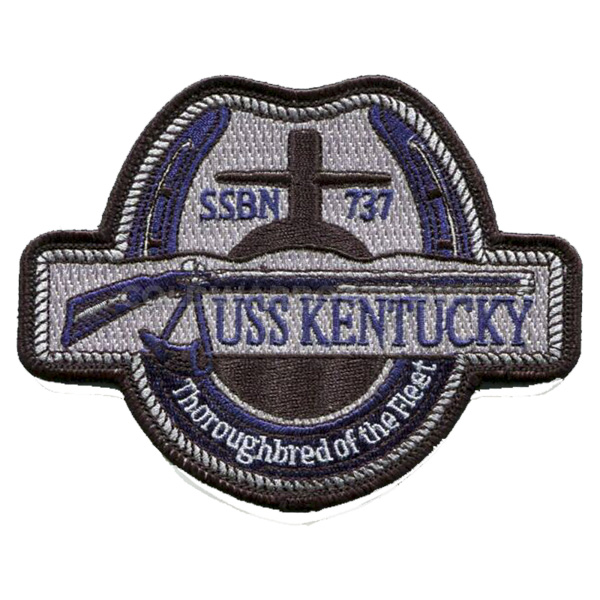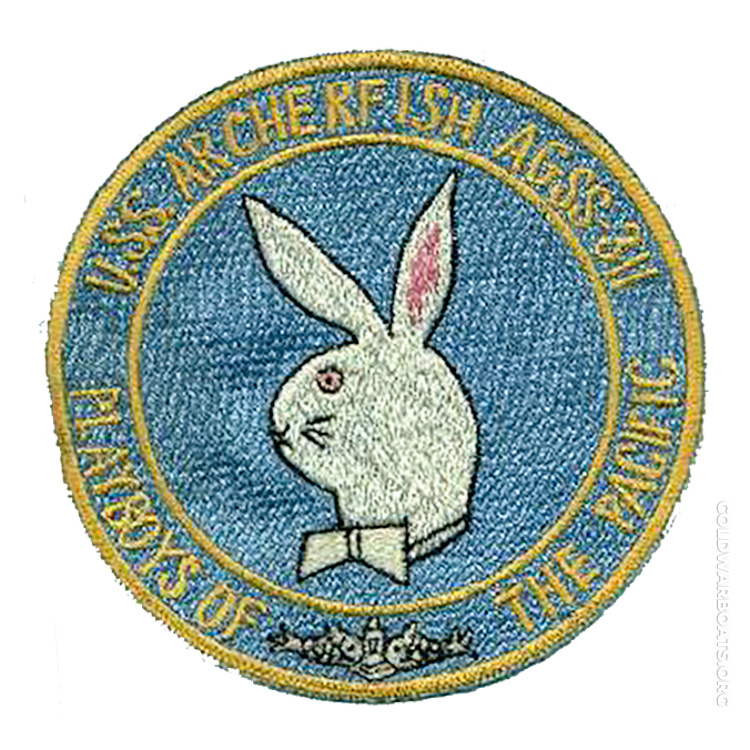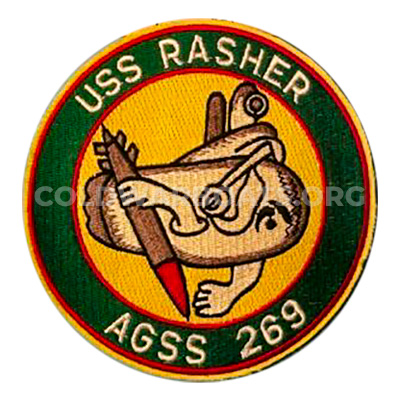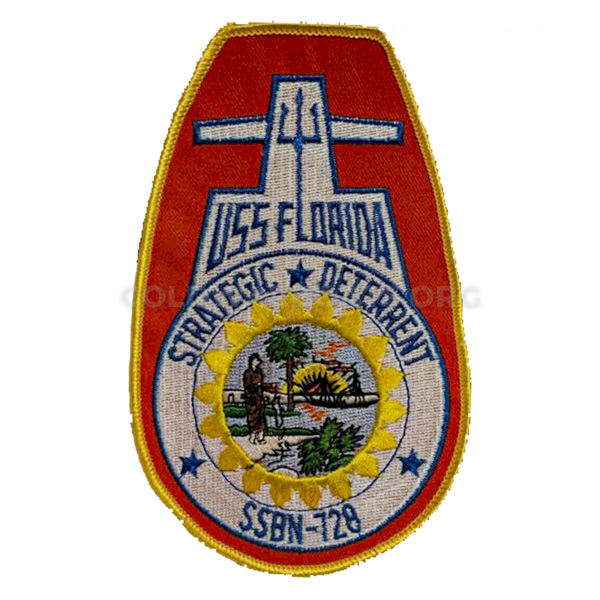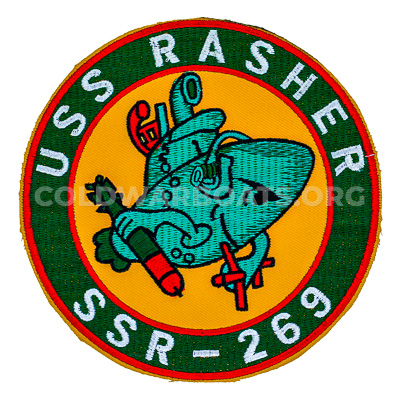The USS WILLIAM H. BATES (SSN 680), a Sturgeon class nuclear powered attack submarine, was originally going to be named the Redfish when the contract to build her was awarded to the Ingalls Nuclear Shipbuilding Division of Litton Industries in Pascagoula, Mississippi on June 25, 1968.
Upon the death of Congressman William H. Bates, in June of 1969, she was renamed, and the keel laid down on August 4, 1969, as the only ship of the United States Navy to be named for that staunch supporter of the nuclear Navy.
The William H. Bates was launched on December 11, 1971, sponsored by Mrs. Andrew R. Grainger, the wife of Ensign Andrew R. Grainger and the daughter of Representative Bates. First sea trials took place on February 9, 1973, and the boat was commissioned on May 5, 1973, with Commander Glen N. Arthur, Jr., in command.
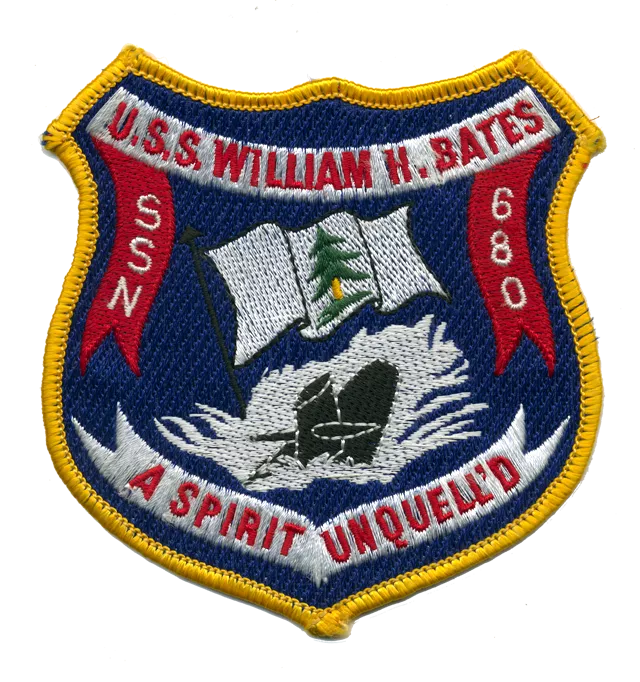 After shakedown, the USS WILLIAM H. BATES (SSN 680) was home-ported at New London, Connecticut, where she worked out of the submarine base at Groton.
After shakedown, the USS WILLIAM H. BATES (SSN 680) was home-ported at New London, Connecticut, where she worked out of the submarine base at Groton.
She was deployed to the eastern Atlantic between July and October 1974 and conducted her first patrol mission before visiting Holy Loch, Scotland, and Halifax, Nova Scotia, en route home. However, her respite was brief, for the nuclear attack submarine was again underway on patrol over the Christmas holidays and into January 1975. After voyage repairs at Holy Loch, USS WILLIAM H. BATES (SSN 680) shifted to Faslane, Scotland, for a port visit.
Sailing for home in late January, the submarine was refitted at the Norfolk Naval Shipyard, Portsmouth, Va., before conducting local operations off Ft. Lauderdale, Fla., into the summer of 1975. She was deployed to European waters again soon thereafter, taking part in antisubmarine warfare exercises. In November, the submarine took part in NATO Exercises "Moby Dick" and "Ocean Safari 75," before she returned to New London in December.
USS WILLIAM H. BATES (SSN 680) conducted her first Mediterranean deployment the following year, departing New London on 5 May 1976. During this tour, she honed her skills in exercises with other ships of the United States Navy and other NATO naval units. During the deployment, she visited Bizerte, Tunisia; Augusta Bay, Sicily; and La Spezia and Naples, Italy. After departing the Mediterranean on 6 September 1976, the submarine took part in Exercise "Ocean Safari 76" in mid-month. On 14 October, the submarine returned to Groton.
USS WILLIAM H. BATES (SSN 680) underwent voyage repairs and later prepared for another overseas deployment. She departed Groton during the summer of 1977 and completed her assigned mission on 3 October, mooring alongside the tender Holland (AS-32) on that day. She subsequently transited the North Sea for a port visit to Bremerhaven, Germany, where she spent five days. USS WILLIAM H. BATES (SSN 680) then took part in Exercise "Ocean Safari 77" with NATO units while returning from European waters to Groton.
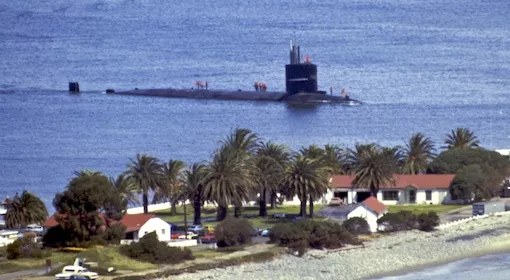
From there, USS WILLIAM H. BATES (SSN 680) operated in the Atlantic until moving to San Diego in May 1978 for service in the Pacific Fleet.
From 1980 through early 1989, USS WILLIAM H. BATES (SSN 680) operated from San Diego while attached to Submarine Squadron 11, conducting numerous Western Pacific deployments and operations such as "Exercise Team Spirit" with the South Korean Navy and other navies of various nations. While on deployment, she would conduct port visits in Nanaimo, B.C., Pearl Harbor, HI, Subic Bay, PI, Chinhae, Korea, Diego Garcia, Perth, W. A., Yokosuka and Sasebo, Japan, Adak, Alaska, Guam, Satahip, Thailand, and others.
In mid-1989, she transited northward, stopped Mare Island Naval Shipyard in Vallejo, CA for minor repairs and crew morale, then continued up the coast and entered Puget Sound Naval Shipyard in Washington state for an extensive refueling overhaul and retrofit.
In 1991, after completion of overhaul, she was transferred to Pearl Harbor, Hawaii where she completed several Western Pacific deployments and operations.
USS WILLIAM H. BATES (SSN 680) was decommissioned and simultaneously stricken from the Naval Vessel Register on February 11, 2000. The ex-William H. Bates returned to Puget Sound Naval Shipyard and entered the Nuclear Powered Ship and Submarine Recycling Program in Bremerton, Washington. Recycling was completed on March 1, 2002
No known significant portions of the ship remain, with the exception of the sealed reactor compartment in the long-term storage facility at Hanford, Washington. There is at least one known palm-sized cube of hull material in the possession of one of our shipmates, but apart from this, the boat lives only in our memories.
Specifications:
- Awarded: June 25, 1968
- Keel Laid: August 4, 1969
- Launched: December 11, 1971
- Sea Trials: February 9, 1973
- Commissioned: May 5, 1973
- Decommissioned: February 11, 2000
- Stricken: February 11, 2000
- Recycled: March 1, 2002
- Builder: Ingalls Shipbuilding, Pascagoula, Miss.
- Propulsion system: one S5W2 nuclear reactor
- Screw: one
- Length: 302 feet (91.5 meters)
- Beam: 31.7 feet (9.65 meters)
- Draft: 29.2 feet (8.9 meters)
- Displacement, surfaced: approx. 4,200 tons
- Displacement, submerged: approx. 4,700 tons
- Speed: Surfaced: in excess of 15 knots
- Speed: Submerged: in excess of 20 knots
- Armament: four 533 mm torpedo tubes for Mk-48 torpedoes, Harpoon, Tomahawk, and SUBROC missiles, ability to lay mines
- Crew: 14 Officers, 112 Enlisted
Sources: Dictionary of American Naval Fighting Ships, www.navysite.de, Wikipedia

